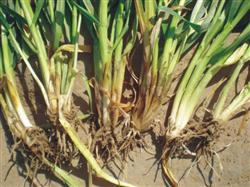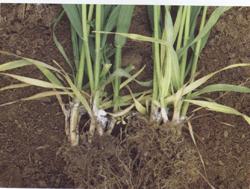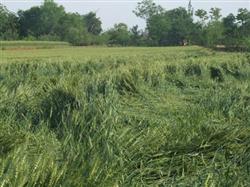Occurrence and control of wheat sheath blight in spring

Wheat sheath blight is a kind of fungal disease which is mainly transmitted by soil. With the improvement of the level of yield, the harm of the popularization of high-yield varieties and the management of wheat fields with heavy water and fertilizer is becoming more and more serious. Rhizoctonia solani has a wide host range, which can infect not only wheat, but also corn, rice, millet, sorghum and other crops and Gramineae weeds such as bristlegrass, cricket grass, cottongrass, barnyardgrass and so on. The main source of infection is sclerotia or hyphae overwintering and summer in soil and diseased remains. After sowing, if the wheat is infected by germs, the coleoptile turns brown, the weight will rot and die; after jointing, the diseased plant rate increases obviously, the wheat disease develops rapidly at booting and heading stage, the diseased plant rate reaches the peak at flowering and filling stage, and the disease spot expands, it connects with each other into typical moire spots, and later invades the stem to cause rotting stem, even forming withered and white spike, less fruiting and thin grain. The prevention and control methods are as follows: 1. Agricultural prevention and control. Timely control of weeds can reduce field humidity, improve field ventilation and light transmission conditions, implement formula fertilization, topdressing at jointing stage, and combined topdressing of nitrogen and potassium fertilizer, which can effectively improve plant disease resistance and avoid partial application of nitrogen fertilizer. so as not to cause late ripening of wheat seedlings and aggravate the disease. two。 Chemical control. The chemical control of wheat sheath blight should focus on seed treatment, and the seriously diseased fields should be supplemented by relay spraying in early spring to effectively control the disease. (1) Spring prevention and control: according to the condition of the investigation, early spraying should be carried out to prevent the disease. During the starting period of wheat, if the rate of diseased plants in the field is 15% and 20%, 12.5% WP 20g / mu or 15% triadimefon WP 50g 100g or 5% Jingangmycin water 150ml / mu should be sprayed on the middle and lower parts of wheat plants with water of 50kg / mu and 75kg / mu, and then sprayed once every 7 days for 2 times. Spray 60 kg of water with 15% triadimefon wettable powder 50 grams per mu at booting stage. If diseases and insect pests occur at the same time, the mixed use of pesticides such as wheat aphid and wheat spider can be used to achieve the purpose of simultaneous treatment. (2) if sheath blight occurs early and seriously in autumn seedling stage, there are more Rain Water in spring, and the disease is likely to occur, the control index should be strictly controlled and the control time should be advanced appropriately.
- Prev

Wheat catch four defenses in spring
1. Occurrence and harm of wheat sheath blight wheat sheath blight is a kind of fungal disease mainly transmitted by soil. With the improvement of the level of yield, the harm of the popularization of high-yield varieties and the management of wheat fields with heavy water and fertilizer is becoming more and more serious. The host range of wheat sheath blight is wide, in addition to infecting wheat, but also.
- Next

Guidance on fertilization Management of Wheat in Spring
1) spraying paclobutrazol. Spraying 30kg 200ppm paclobutrazol solution per mu could dwarf the plant, enhance its lodging resistance, cure wheat powdery mildew and improve the absorption and utilization of nitrogen. (2) spraying chlorpheniramine. For large and prosperous wheat fields, spray 0 mu at the early stage of jointing.
Related
- The first cup of black tea in spring, the flavor and history of tea gardens in Kenya, Africa
- The computer can not only choose potatoes, but also grow tea rice. AI will grow winter oolong tea champion.
- It is not only the inflated tea bitten by insects, but also engraved with the four seasons tea in Beipu.
- The Oriental Beauty Tea Festival in Zhuxian County takes the stage at the weekend to experience the plus-size feast of oil tea.
- & quot; Oriental Beauty Tea & Exploration of Emei in Hsinchu, the hometown of quot;
- The new variety of strawberry "Tainong 1" dessert is the first choice with mellow aroma. Crimson gorgeous
- History of Tea in Taiwan: from Wild Inner Mountain to Export Tea Garden
- Two types of Taiwan Oriental Beauty Black Tea won the British three-Star Award for Childhood Tea Xiang Zhang Jiaqi changed from pilot to champion tea maker.
- Banana species and varieties: the planting history of Taiwan Xianren banana and dwarf banana is long, is banana disease resistant?
- Coffee planting Technology: Qianjie Coffee from Seedling to harvesting

